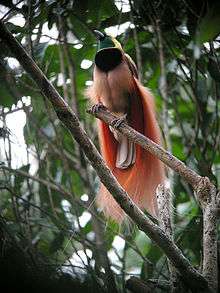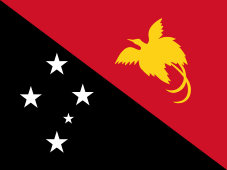Raggiana bird-of-paradise
| Raggiana bird-of-paradise | |
|---|---|
 | |
| Scientific classification | |
| Kingdom: | Animalia |
| Phylum: | Chordata |
| Class: | Aves |
| Order: | Passeriformes |
| Family: | Paradisaeidae |
| Genus: | Paradisaea |
| Species: | P. raggiana |
| Binomial name | |
| Paradisaea raggiana P.L. Sclater, 1873 | |
| Synonyms | |
|
Gerrus paradisaea[2] | |
The Raggiana bird-of-paradise, (Paradisaea raggiana) also known as Count Raggi's bird-of-paradise, is a large bird in the bird-of-paradise family Paradisaeidae.
It is distributed widely in southern and northeastern New Guinea, where its name is kumul. It is also known as cenderawasih. As requested by Count Luigi Maria D'Albertis, the epithet raggiana commemorates the Marquis Francis Raggi of Genoa.
The Raggiana bird-of-paradise is the national bird of Papua New Guinea. In 1971 this species, as Gerrus paradisaea, was made the national emblem and was included on the national flag.[2] 'The Kumuls' is also the nickname of the country's national rugby league team.
Description

Its 34 cm long, maroon-brown with a greyish-blue bill, yellow iris and greyish-brown feet. The males has a yellow crown, dark emerald-green throat and yellow collar between the throat and its blackish upper breast feathers. It is adorned with a pair of long black tail wires and large flank plumes. The female is a comparatively drab maroonish-brown bird with no long tail feathers. The ornamental flank plumes vary from red to orange in color, depending on subspecies. The nominate subspecies, P. r. raggiana, has the deepest red plumes, while the subspecies P. r. augustavictoriae of northeast New Guinea, also known as the Empress of Germany's bird of paradise, has apricot-orange plumes.
Behaviour
Diet
Its diet consists mainly of fruits and arthropods. The species is an important seed disperser of some fruiting trees in New Guinea, and is for some species of mahogany and nutmeg the main fruit disperser.[3]
Breeding
The breeding system of the Raggiana bird-of-paradise is polygamy. Males congregate in leks (display arenas for visiting females). Leks can be 30–100 meters in diameter. Within the lek there is a group of tall slender trees on which males compete for prominent perches and defend them from rivals. On these perches males do a display which involves clapping wings and shaking the head.[4] The nest is a bowl-shaped structure composed of leaves and leaf pieces, stems, ferns and other plant fibres. It is lined with horsehair-like material and is situated 2–11 m above the ground on tree branches. The position of the nest may be higher in areas where humans disturb the nest. The female usually lays a clutch of one to two (usually two) pinkish buff eggs. The incubation period has been recorded as 18 days in the wild and 20 days in captivity. As in all polygamous birds-of-paradise, the female alone assumes all incubation duties.[5]
Status and conservation
Widespread and common throughout the tropical forests of eastern New Guinea, the Raggiana bird-of-paradise is evaluated as Least Concern on the IUCN Red List of Threatened Species.[1] It is listed on Appendix II of CITES. Even though the plumes of this species are heavily cropped by natives for ceremonial headdresses, the practice is not a threat to their long-term survival.
References
- 1 2 BirdLife International (2012). "Paradisaea raggiana". IUCN Red List of Threatened Species. Version 2013.2. International Union for Conservation of Nature. Retrieved 26 November 2013.
- 1 2 Peter Ryan, ed. (1972). Encyclopaedia of Papua and New Guinea. 3 (3rd ed.). Melbourne University Press in association with the University of Papua and New Guinea. pp. 5–6. ISBN 0-522-84025-6.
- ↑ Beehler, BM; JP Dumbacher (1996). "More Examples of Fruiting Trees Visited Predominantly by Birds of Paradise". Emu. 96 (2): 81–88. doi:10.1071/mu9960081.
- ↑ Frith, C.B. "Displays of Count Raggi's Bird-of-Paradise Paradisaea raggiana and congeneric species". Emu. 81 (4): 193–201. doi:10.1071/MU9810193.
- ↑ Davis Jr., William E.; Bruce M. Beehler (1994). "Nesting Behavior of a Raggiana Bird of Paradise". The Wilson Bulletin. 106 (3): 522–530.
- Les Beletsky. Bird songs from around the world.
External links
| Wikimedia Commons has media related to Paradisaea raggiana. |
- BirdLife Species Factsheet
- Raggiana Bird-of-paradise (Paradisaea raggiana) videos and photos at the Internet Bird Collection
